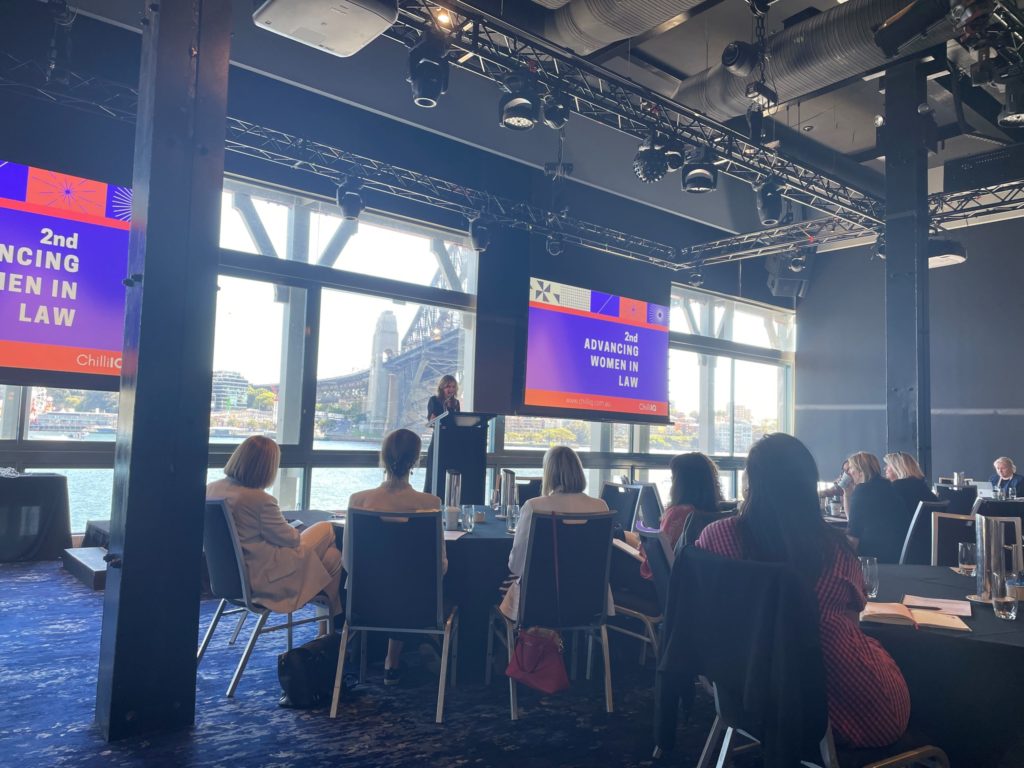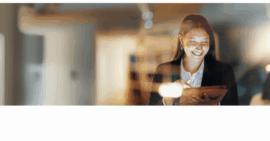Set against a backdrop of Sydney’s glistening harbour, Chilli IQ hosted its 2nd Advancing Women in Law forum, to weigh in on diversity, equity and inclusion (DEI) from every angle, and tackle the important challenges faced by the legal profession.
Prominent advocate for families and women in the workforce Georgie Dent and award-winning journalist David Leser joined an exceptional line up of legal leaders and change makers to discuss flexible work hours, parental leave, hybrid models and nurturing young talent as tipping points for the next generation of female leaders.
In global analysis conducted by Thomson Reuters with thousands of corporate law departments, DEI was identified as one of the critical levers of client satisfaction, indicating that those with progressive DEI features are more likely to elevate the client experience and deliver stronger, more effective working relationships.
“Creating a future gender-neutral workforce starts with strengthening the pathways to leadership and a culture of change and inclusion.”
Conference Director, Jenny Katrivesis
When you attend an event with this calibre of speakers, you know you’re in for a treat. We highlight the sessions here and reveal the strategies needed to navigate the changing DEI landscape and build a stronger, more inclusive legal workforce.
Redesigning the way lawyers work
The pandemic sparked “the greatest shift we have seen in the workforce for over a century,” opens Alison Hernandez, APAC Director of HSM Advisory. “The days of go to work, come home and repeat is over.”
To navigate the hybrid work model and radically transform organisations successfully, Alison shares this four-step framework (hint: it’s all about building trust and sustainable high performance):
Step 1: Understand the challenges your business is facing;
Step 2: Reimagine creative, new approaches and processes to achieve what really matters;
Step 3: Model and test these within your organisation,
Step 4: Act and create. Co-create with your people instead of for your people.
The framework is based on the book, Redesigning Work by global thought leader and founder of HSM Advisory, Professor Lynda Gratton, who conveys the premise that to increase productivity you must embrace the new ways of working. Lynda brings insights from 30 years of research into the technological, demographic, cultural and societal trends shaping work.
Hybrid work is here to stay
The pandemic accelerated a fundamental shift in priorities with a renewed focus on work-life balance, mental health, purpose and flexibility. Gratton’s survey revealed that four out of five surveyed (80%) preferred a hybrid working model and 66% would leave their jobs if this was denied.
The study evaluated tension points with 350 finance leaders across the globe, and one in four (25%) cited grappling with the status quo versus the new world as their greatest challenge.
“Hybrid work is here to stay and needs to be voluntary and intentional, not mandated,” asserts Alison. If organisations try to enforce the status quo, it will come at the price of performance. “Everyone is counting how many people are in the office, which is too simplistic a view.” The take-home message? We need to shift the mindset that presence isn’t key, but rather ask what work is getting done.
How can we foster increased collaboration?
Human connection helps create a collective identity, a sense of belonging and a common purpose. “Purpose has been revisited since the pandemic, so it is important to effectively evaluate the business to uncover this,” says Alison.
Gratton’s research shows a 56% improvement in job performance and 75% less sick days when people intrinsically feel they belong and do meaningful work.
Meeting the needs of the business
Do you have a clear narrative about the future for your team? What do your stakeholders want? The key is to keep circling back to understanding and upskilling leaders with human centric skills, hybrid enabling skills and performance-focused leadership skills.

Better solutions for working parents
What would make Australia the best place to be a parent? This is the question posed in the keynote session. Georgie Dent is Executive Director of The Parenthood, a prominent not-for-profit advocacy group.
“Pregnancies have overtaken disability as the highest form of discrimination in the workplace,” says Georgie. A survey released last week reveals more than four in five women (84%) reported impact, of which 32% resigned. “It doesn’t have to be this way.”
Georgie emphasises the gravity of the role parents have in raising the generation of the future, particularly in the first twelve months, as the proportion of care pattern during this time usually carries on throughout the life of the child.
Reconciling the binary choice systemically imposed
Georgie highlights three key areas that need reshaping to lift productivity, reduce inequity and position Australia as the best place to be a parent:
- Adequate and equitable paid leave. The global average is 52 weeks paid leave shared between both parents. Australia offers 26 weeks to the mother and just two weeks for the father, calculated at minimum wage.
- Universal access to affordable childcare. Access to public school is not wage-based, but childcare is. It is estimated that 7% of our salary is spent on childcare however 345,000 Australians spend more.
- Family-friendly workplace culture. Not fitting into the traditional framework of work doesn’t make you unprofessional. Mothers should not have to choose between work and parenting.
There is a growing chasm between a woman’s education attainment and progression of career. A female salary drops when she enters motherhood and it rarely fully recovers. The Parenthood estimates a ‘motherhood penalty’ of around $685,000 in salary and $180,000 in super over the course of their career, while men are largely unaffected by entering into parenthood.
What can we do to change Australia’s working parents’ story?
Georgie encourages everyone to get involved. As individuals, we can recognise and accept the limitations and adjust our expectations. A workplace can create a culture that values parenting and introduce better policies. As a society, we continue to campaign for reform. Policy and practices need to align as the status quo is no longer fit for purpose.
“A workplace can create a culture that values parenting and introduce better policies.”
Georgie Dent
Approximately 60% of law firms offer paid parental leave, which is not enough. “The reckoning among women during the pandemic transformed the way we work,” says Georgie. “We have to pursue evidence-based policy to reduce inequity and there is still a lot of work to do to achieve the scale of reform we need.”
Is equity trending?
As much as there is work to do, we also need to celebrate the progress. There is no doubt we are building DEI muscle with impactful initiatives that keep evolving.
The Law Society of NSW reported more than half the lawyers in Australia (53%) are women, compared to 46% ten years ago. Fifty five percent of all first nations solicitors are women, and in South Australia and Tasmania, there are two female lawyers for every male in the corporate legal space.
The 2022 Board Diversity Index notes that the number of companies among the ASX300 with at least 30% women board directors has tripled since 2016 in Australia.
Women, men and the whole damn thing
When a man introduces a history of patriarchy, misogyny and the forces holding men back from becoming better allies to the women in their lives, you know it’s going to be a riveting session.
“I thought I had the territory mapped”, says David Leser, Walkley award winning journalist and self-confessed ‘privileged white man’, who grew up learning that women could be objectified. Through his later research and rumination, he uncovered the deep-rooted history of what is arguably the world’s oldest bias and confronted his role in it.
Aristotle once said that “women are defective men, with rational and moral capacities inferior to men”. Although skills around respect, connection and empathy have progressed since this shocking statement, David suggests that modern manhood still has a long way to go.
“The next part of the women’s movement is actually a men’s movement, that rejects so many of the old definitions of masculinity.”
David Leser
How can men be part of the gender equity solution?
David believes men are desperate to transform and travel far from their forefathers and grandfathers, which is evident in the growing army of them determined to rewrite the playbook of masculinity and find a new emotional language.

The wisdom of women
Panel discussions led by legal leaders continued throughout the day around these prominent issues facing the legal sector:
Equitable flexibility
Explores the premise that gender parity directly correlates to improved culture and the financial performance of a company. “The pandemic demonstrated how flexibility at scale unlocks economic potential in the workplace,” says Jenny. “This enables organisations to optimise productivity and performance while tapping into a deeper talent pool“. Companies have goals around everything so why not flexibility?
Elevating culturally diverse women into positions of leadership
What are diversity best practices and how do we get people on board? Diversity is an asset and working with firms who reflect similar values is key to overcoming the need to fit the mould in an entrenched legal environment. While Australia is a culturally diverse nation, we still have minimal representation in the law and leaders can help bridge this gap by aligning values. “Change happens through our clients and our people, not through law firms,” says MinterEllison Partner Donna Worthington.
First nations women in law
A valuable discussion around the need to increase indigenous representation in law through ongoing mentorships and access to education. This not only improves diversity within the legal profession but can improve outcomes by creating cultural pathways towards greater prosperity.
Paving the way for the next generation of women lawyers
Bill Gates once said, “we often over-estimate what we can do in a year, but we under-estimate what we can do in ten years”. What could the legal profession look like in ten years? Flexible working and inclusion are key to attracting, engaging and retaining diverse talent of the future. This generation are either entrepreneurs or balance seekers, and both want to align on company principles while feeling valued and accepted.
DEI as modern feminism
It goes without saying that feminism has come a long way since the metaphorical bra burning 60’s and even today, feminine discourse can be a polarising topic to unpack.
After spending the day absorbing the insights of these powerful exemplary DEI advocates and hearing firsthand about their advances and inroads, I have a newfound appreciation for the contribution they are making for women all over the world. For me.
I’m on board and understand the importance of flexing my own DEI muscle. It takes just one to start a change, but it takes an army to create significant and lasting impact.
Like this article? Read about the 15th Annual Managing Partners Forum by this author.


